2. Electrical and Electronic Engineering, University of Technology, Sydney 2007, Australia
2. Electrical and Electronic Engineering, University of Technology, Sydney 2007, Australia
水声通信技术广泛应用于海洋油气资源的勘探,海洋污染监测,水下救援,水下潜艇定位和导航以及水下作业等领域[1]。水声信道具有严重的多途干扰特性[2-4],使得接收信号产生畸变,影响通信系统性能,当通信载体产生巨大脉冲噪声干扰时,比如收发船发动机运行时进行通信,发动机产生巨大脉冲噪声,使得通信系统解码性能迅速降低甚至解码失效。
当前水声通信调制解调方式主要分为4种:多进制频移键控(Multiple Frequency Shift Keying, MFSK)、单载波多进制相移键控(Single Carrier Multiple Phase Shift Keying, SC-MPSK)、扩频(Spread Spectrum, SS)和正交频分复用(Orthogonal Frequency Division Multiplexing, OFDM)水声通信算法。
MFSK的特点是性能稳健但是数据传输速率低,不能满足当下高速通信的需求[5-6];SC-MPSK的应用使数据传输速率有了显著的提高,但是受信道影响大、带宽利用不充分[7];扩频水声通信技术具有很强的抗干扰能力,并且可以在低信噪比的条件下保证通信质量,但是数据传输速率低[8-9]。OFDM是多载波传输方案的实现方式之一,数据传输速率高,目前已广泛应用于各种无线通信中[10-11]。由于OFDM采用多载波调制,在码元中加入循环前缀(Cyclic Prefix, CP)来对抗多途效应,并且能将噪声的能量分散到各个子载波上,减小了噪声对系统的影响,提供可靠通信,在水声通信系统中被广泛使用。因此本文提出基于双编码策略的水声OFDM通信算法(Underwater acoustic OFDM communication algorithm based on dual encoding strategy, DE-OFDM),构建抗船舶噪声和时变多途干扰的通信体制。
1 DE-OFDM算法原理DE-OFDM算法可有效对抗多途干扰,其基本思想是将要传输的数据流分配到正交的子载波上并行传输,当子载波带宽低于信道相干带宽时,呈现频率平坦衰落,再加以CP,从而减小多途的影响。
DE-OFDM水声通信系统结构如图1所示。在发射端,输入比特

|
图 1 DE-OFDM水声通信系统结构 Fig. 1 DE-OFDM underwater acoustic communication system structure |
DE-OFDM算法采用信道卷积编码,卷积码输出的编码比特不仅与本组的信息有关,还与前面若干组的信息有关,可以起到很好的抗干扰作用。(n, k, m)卷积码在编码时把k个信息比特编成n个信息比特(k和n通常很小),m为编码约束长度,说明编码过程中有m组信息比特相互约束。卷积码的码率R=k/n,随着码率降低,抗干扰能力逐渐增强。本算法(3, 1, 9)卷积码如图2所示,码率R=1/3,3个输出比特与当前输入的1个信息比特和前8个信息比特有关。编码运算为:

|
图 2 (3, 1, 9)卷积编码器 Fig. 2 (3, 1, 9) Convolutional coder |
| $\left\{ \begin{array}{l} {c_1} = {s_1} \oplus {s_3} \oplus {s_4} \oplus {s_6} \oplus {s_7} \oplus {s_8} \oplus {s_9} {\text{,}}\\ {c_2} = {s_1} \oplus {s_2} \oplus {s_4} \oplus {s_5} \oplus {s_8} \oplus {s_9} {\text{,}} \\ {c_3} = {s_1} \oplus {s_2} \oplus {s_3} \oplus {s_6} \oplus {s_9} {\text{。}} \\ \end{array} \right.$ | (1) |
式中:
定义
| ${\mathbf{\theta }} = {\left[ {{\theta _0}, \cdot \cdot \cdot ,{\theta _i}, \cdot \cdot \cdot ,{\theta _{N - 1}}} \right]^{\rm{T}}}{\text{,}}$ | (2) |
串并转换将相位信息序列分为N块,每块长度为K,满足I = N×K,相位信息矩阵可写为:
| $\begin{split} {\mathbf{\theta }}_{N \times K} =& \left[ {{\mathbf{\theta }}_0}, \cdots ,{{\mathbf{\theta }}_k}, \cdots ,{{\mathbf{\theta }}_{K - 1}} \right] =\\ & \left[ \begin{array}{*{20}{c}} {\theta _{0,0}}& {\cdots} &{\cdots} & {\cdots}&{\theta _{0,K - 1}} \\ {\vdots}&{\ddots} &{\rm{ }}& {\rm{ }} &{\vdots} \\ {\theta _{n,0}}&{\rm{ }}&{\theta _{n,k}}&{\rm{ }}&{\theta _{n,K - 1}} \\ {\vdots} &{\rm{ }}&{\rm{ }}& {\ddots}& {\vdots} \\ {\theta _{N - 1,0}} &{\cdots}& {\cdots}& {\cdots}&{\theta _{N - 1,K - 1}} \end{array} \right] \end{split} {\text{,}}$ | (3) |
| ${{\mathbf{\theta }}_r} = {\left[ {{\theta _{{r_{\rm{0}}}}}, \cdot \cdot \cdot ,{\theta _{{r_n}}}, \cdot \cdot \cdot ,{\theta _{{r_{N - 1}}}}} \right]^{\rm{T}}}{\text{,}}$ | (4) |
则此时相位信息序列为
| ${{\mathbf{\theta '}}_{N \times \left( {K{\rm{ + 1}}} \right)}} = \left[ {{{\mathbf{\theta }}_r},{{\mathbf{\theta }}_{N \times K}}} \right]{\text{,}}$ | (5) |
用前后码元之间的相位差传输信息,差分过程如图3所示。第一列相位

|
图 3 差分编码 Fig. 3 Differential coding |
| $\begin{split} {\boldsymbol{d}}=& \left[ {{{\boldsymbol{d}}_0}, \cdots ,{{\boldsymbol{d}}_k}, \cdots ,{{\boldsymbol{d}}_{K - 1}}} \right] = \\ & \left[ \begin{array}{*{20}{c}} {d_{0,0}}& {\cdots} &{\cdots} & {\cdots}&{d_{0,K - 1}} \\ {\vdots}&{\ddots} &{\rm{ }}& {\rm{ }} &{\vdots} \\ {d_{n,0}}&{\rm{ }}&{d_{n,k}}&{\rm{ }}&{d_{n,K - 1}} \\ {\vdots} &{\rm{ }}&{\rm{ }}& {\ddots}& {\vdots} \\ {d_{N - 1,0}}&{\cdots}& {\cdots}& {\cdots}&{d_{N - 1,K - 1}} \end{array} \right] \end{split}{\text{。}} $ | (6) |
差分编码用前后码元之间的相位差传输信息,经差分编码后的相位信息可表示为
| ${{\boldsymbol{x}}_k}\left( m \right) = {\rm{IFFT}}\left[ {\boldsymbol{d}}_k \right]{\text{。}}$ | (7) |
得到时域矩阵
| ${\boldsymbol{x}}\left( m \right){\rm{ = }}\left[ {{{\boldsymbol{x}}_0}\left( m \right), \cdots ,{{\boldsymbol{x}}_k}\left( m \right), \cdots ,{{\boldsymbol{x}}_{K - 1}}\left( m \right)} \right]{\text{,}}$ | (8) |
其中:
经过水声信道后,得到接收信号为:
| $\tilde y\left( t \right) = \sum\limits_{p = 0}^{P - 1} {{A_p}} \left( t \right)\tilde x\left[ {t - {\tau _p}\left( t \right)} \right] + {n_e}\left( t \right) + {n_s}(t){\text{。}}$ | (9) |
其中,时变水声信道多途数为P,第p条路径的增益为
在接收端,先进行A/D转换、同步检测、串并转换、去CP后,得到时域接收矩阵[8]为:
| ${\boldsymbol{y}}\left( m \right){\rm{ = }}\left[ {{{\boldsymbol{y}}_0}\left( m \right), \cdots ,{{\boldsymbol{y}}_k}\left( m \right), \cdots ,{{\boldsymbol{y}}_{K - 1}}\left( m \right)} \right]{\text{,}}$ | (10) |
进行FFT变换,得到:
| ${{\boldsymbol{\hat d}}_k} = {\rm{FFT}}\left[ {{{\boldsymbol{y}}_k}\left( m \right)} \right]{\text{。}}$ | (11) |
可得
传输数据结构如图4所示。1帧数据由多块数据构成,每块数据由循环前缀CP和有效传输数据Data构成,同步头、同步尾采用线性调频信号,LFM1为幅值2 V的线性调频信号,LFM2为幅值1.2 V的线性调频信号,这是为了避免同步检测时检测错误。

|
图 4 传输数据结构 Fig. 4 Structure of Transmitted data |
南海实测水声信道如图5所示,DQPSK100组平均误码率如图6所示,横轴表示信噪比(Signal Noise Ratio, SNR),纵轴表示100组仿真试验平均误码率(Bit Error Rate, BER)。当信噪比达到13 dB时,DQPSK100组仿真试验全部正确解码。
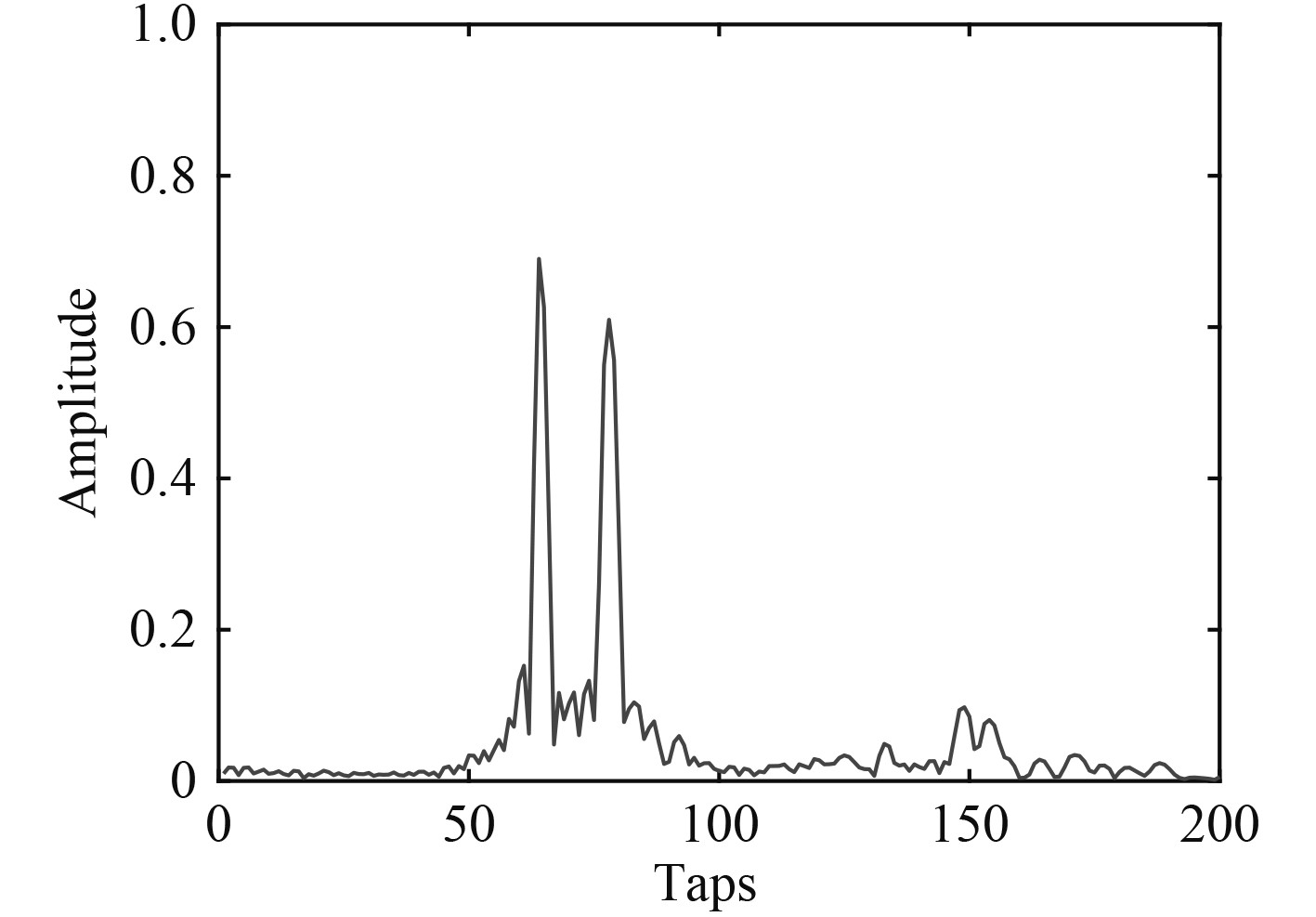
|
图 5 实测南海信道 Fig. 5 Measured south China sea channel |
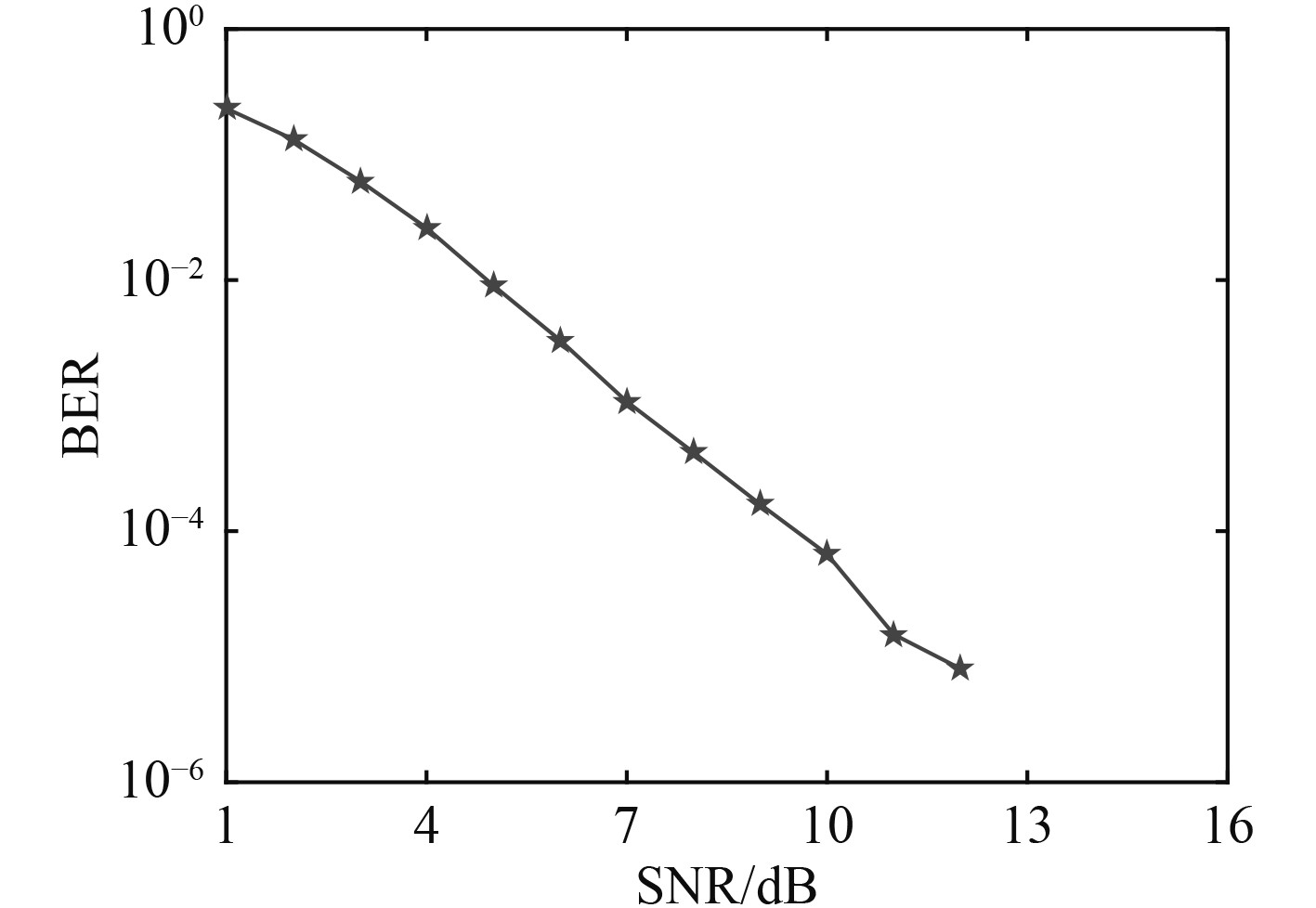
|
图 6 DQPSK100组平均误码率 Fig. 6 Average BERs for DQPSK 100 groups |
2020年7月搭乘胶州湾船舶噪声测量试验,租用一条船接收信号,船上配有220 V,3000 W发电机,保障设备供电,该船以4 m/s速度运动。水听器与钢管刚性连接,置放于水下2 m,钢管与船体刚性连接,因此高速运动时,船舶发动机使得船体震动,带动水听器产生震动,接收信号受到船舶噪声干扰。
试验测量的归一化船舶噪声如图7所示。
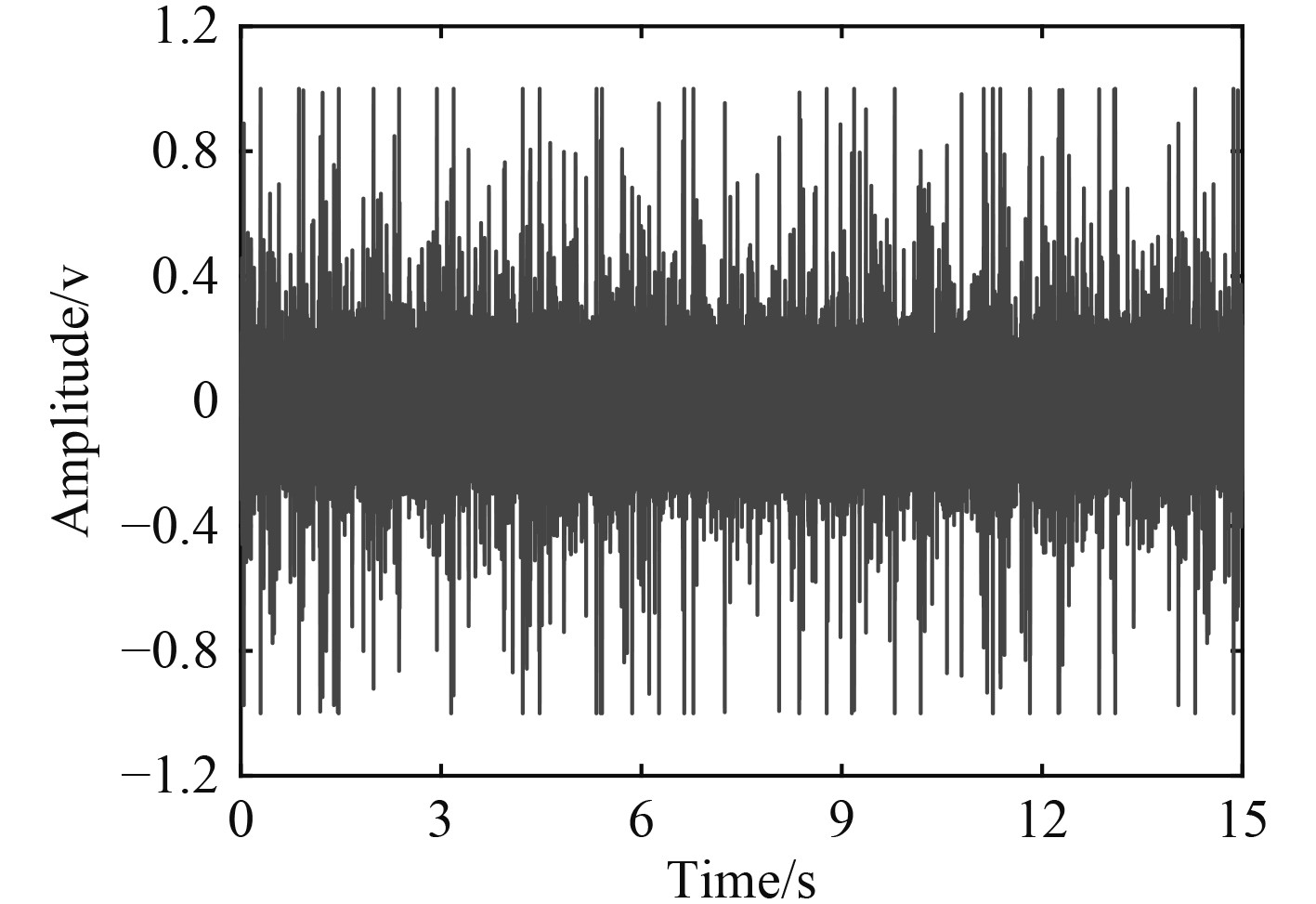
|
图 7 实测船舶噪声 Fig. 7 Measured ship noise |
水箱长1.16 m,宽0.76 m,高0.62 m。收发节点水平距离0.40 m,换能器和水听器布放深度0.50 m。试验时用水盆在水面划水,造成水面波动,增强信道时变性。传输数据结构同仿真。
水箱信道图如图8所示,其中横轴表示时域抽头数,纵轴表示归一化幅度,对比图5可知水箱信道具有强多途干扰。发射、接收信号如图9所示,船舶噪声干扰下的接收信号如图9(c)所示。对比图9(b)可知船舶噪声干扰强。
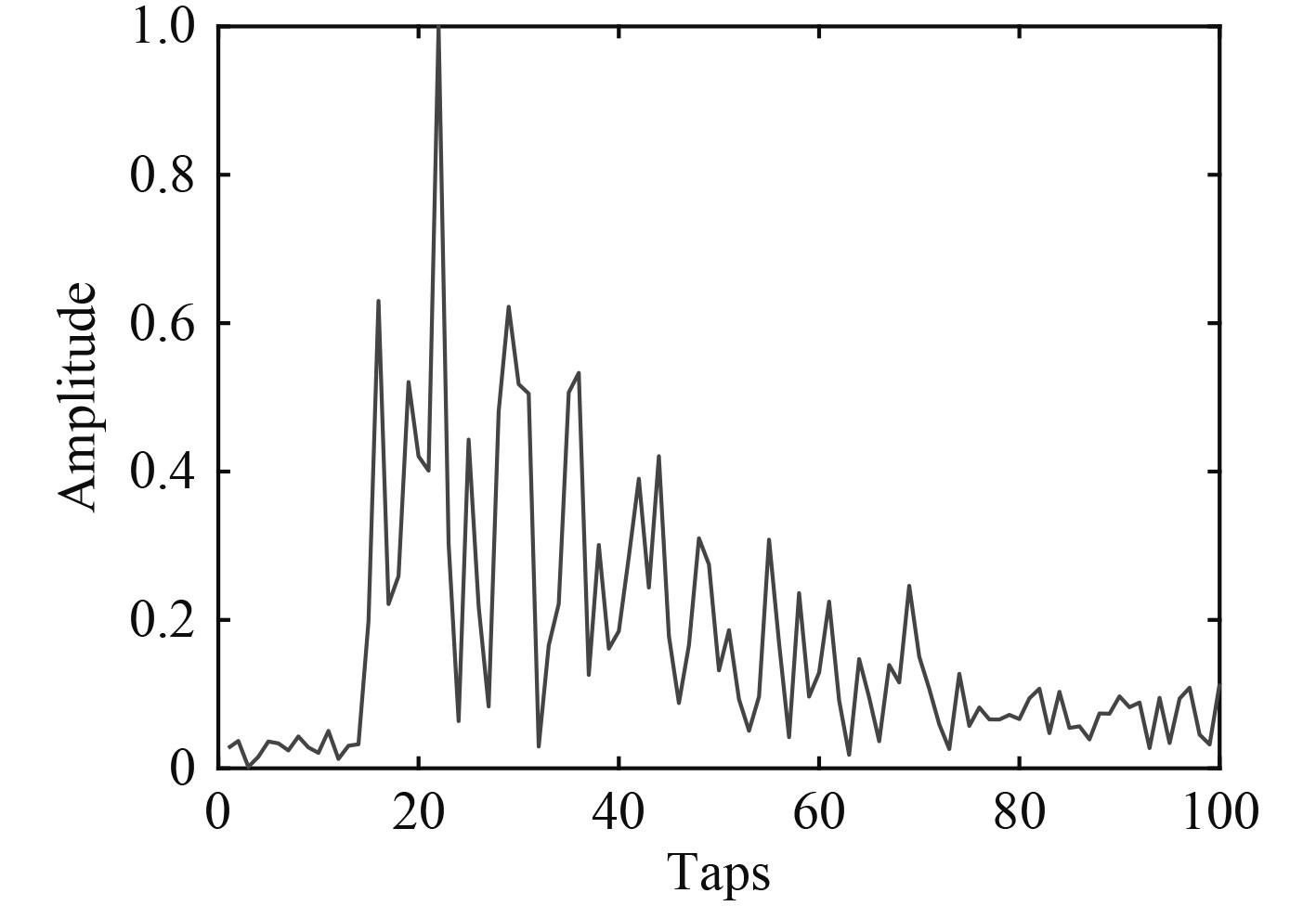
|
图 8 水箱信道 Fig. 8 Water tank channel |
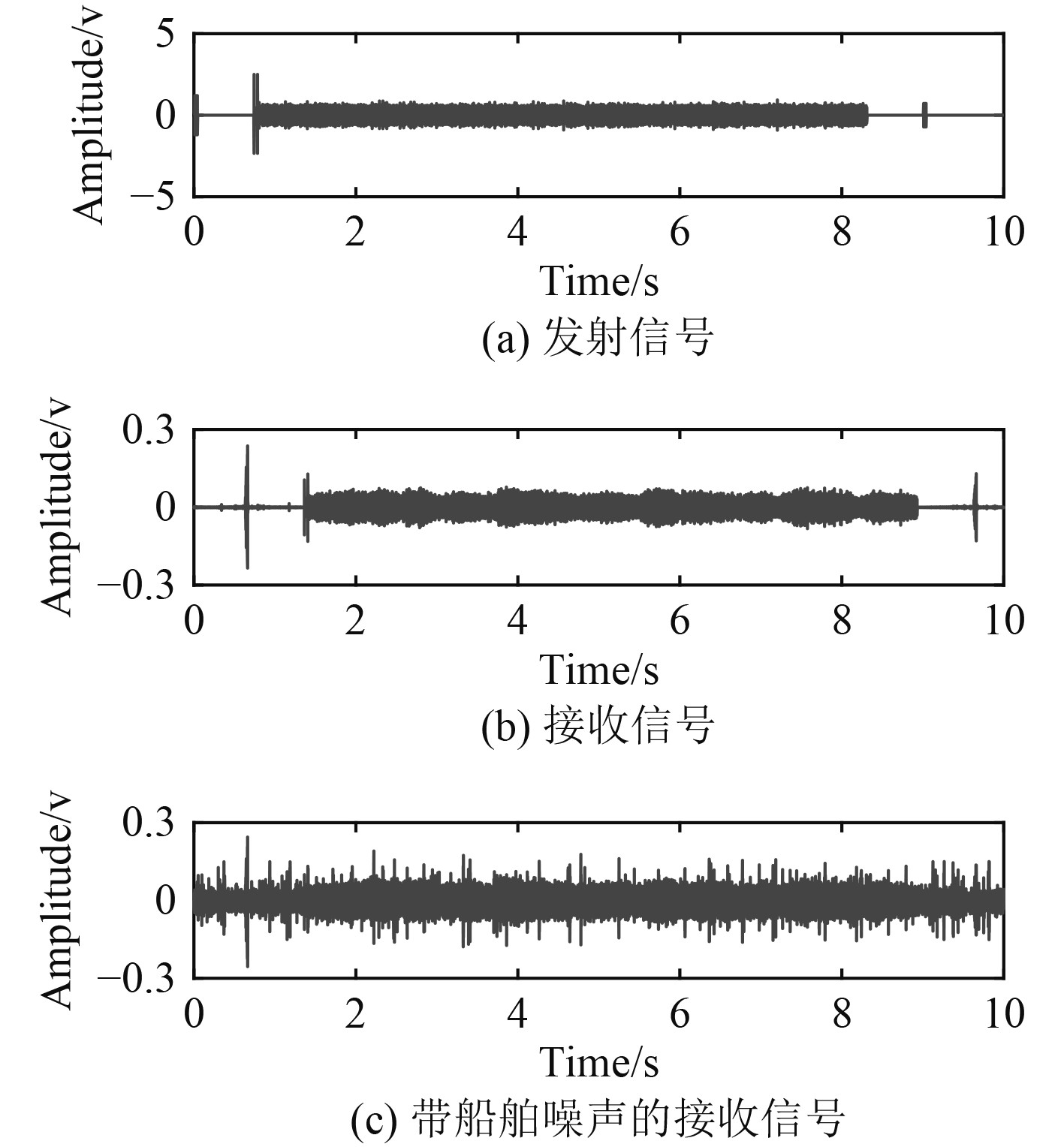
|
图 9 水箱试验 Fig. 9 Water tank test |
由于收发节点距离近,环境噪声影响小,所以加入随机高斯白噪声,获得信噪比1~15 dB的接收信号。采用所提算法,处理带船舶噪声的接收信号,平均误码率如图10所示,横轴代表信噪比,纵轴代表DQPSK100组水箱试验的平均误码率,随着信噪比增大,误码率逐渐降低。信噪比为15 dB时,100组几乎全部正确解码。水箱试验证明了所提算法适用于船舶噪声和时变多途干扰下的可靠水声通信。

|
图 10 平均误码率 Fig. 10 Average BERs |
本文提出DE-OFDM算法,采用信道卷积编码和差分编码有效消除了船舶噪声和时变强多途干扰,基于循环前缀技术以及OFDM通信技术固有的抗多途特性,有效消除了时变多途干扰。南海实测信道仿真和水箱试验结果表明,所提算法可有效解决船舶噪声和时变多途干扰问题,实现可靠水声通信,可为船舶噪声干扰下的海洋运动水声通信奠定基础。
| [1] |
A. SONG, M. STOJANOVIC, M. Chitre. Editorial underwater acoustic communications: where we stand and what is next?[J]. IEEE Journal of Oceanic Engineering, 2019, 44(1): 1-6. DOI:10.1109/JOE.2018.2883872 |
| [2] |
T. C. Yang. Properties of underwater acoustic communication channels in shallow water[J]. Journal of the Acoustical Society of America, 2012, 131(1): 129-145. DOI:10.1121/1.3664053 |
| [3] |
P. QARABAQI AND M. STOJANOVIC. Statistical characterization and computationally efficient modeling of a class of underwater acoustic communication channels[J]. IEEE Journal of Oceanic Engineering, 2013, 38(4): 701-717. DOI:10.1109/JOE.2013.2278787 |
| [4] |
P. B. ZHU, X. M. XU, X. B. TU, et al. Anti-Multipath orthogonal chirp division multiplexing for underwater acoustic communication[J]. IEEE Access, 2020, 8: 13305-13314. DOI:10.1109/ACCESS.2020.2966072 |
| [5] |
孙柏昶, 陈超群. MFSK调制方式在极低速通信中的性能分析[J]. 无线电通信技术, 2019, 45(2): 182-185. DOI:10.3969/j.issn.1003-3114.2019.02.13 |
| [6] |
王楠, 古瑞江, 于宏毅. 一种新型的FSK解调系统设计[J]. 通信技术, 2008(9): 29-31. N. WANG, R. J. GU, et al. A novel design of FSK demodulation system[J]. Communication Technology, 2008(9): 29-31. DOI:10.3969/j.issn.1002-0802.2008.09.011 |
| [7] |
C. B. HE, L. Y. JING, R. XI, et al. Time-frequency domain turbo equalization for single-carrier underwater acoustic communications[J]. IEEE Access, 2019, 7: 73324-73335. DOI:10.1109/ACCESS.2019.2919757 |
| [8] |
程丹. 多径环境下的扩频通信接收技术研究与实现[D]. 四川: 电子科技大学, 2019. D. CHENG. A research and implementation of spread spectrum communication receiving technology in multipath environment[D]. Sichuan: University Of Electronic Science And Technology Of China, 2019. |
| [9] |
魏卓群. 移动稳健扩频水声通信技术研究[D]. 哈尔滨: 哈尔滨工程大学, 2018.
|
| [10] |
尹艳玲, 乔钢, 刘凇佐. 基于虚拟时间反转镜的水声OFDM信道均衡[J]. 通信学报, 2015, 36(1): 94-103. |
| [11] |
朱彤, 桑恩方. 基于正交频分复用的高速水声通信技术[J]. 哈尔滨工程大学学报, 2005(1): 71-74. T. ZHU, E. F. SANG. Research on high speed underwater acoustic communication based on orthogonal frequency division multiplexing[J]. Journal of Harbin Engineering University, 2005(1): 71-74. DOI:10.3969/j.issn.1006-7043.2005.01.015 |
| [12] |
尹艳玲, 乔钢, 刘凇佐, 等. 浅水时变多途信道特性分析与模型实验研究[J]. 声学学报, 2019, 44(1): 96-105. Y. L. YIN, G. QIAO, et al. Shallow water time-varying multipath channel characteristic analysis and model amendment[J]. Acta Acustica, 2019, 44(1): 96-105. |
| [13] |
G. QIAO, Q. SONG, et al. A low-complexity orthogonal matching pursuit based channel estimation method for time-varying underwater acoustic OFDM systems[J]. Applied Acoustics, 2019, 148: 246-250. DOI:10.1016/j.apacoust.2018.12.026 |
| [14] |
S. Y. XING, G. QIAO, et al. A blind side information detection method for partial transmitted sequence peak-to-average power reduction scheme in OFDM underwater acoustic communication system[J]. IEEE Access, 2018, 6: 24128-24136. DOI:10.1109/ACCESS.2018.2829620 |
| [15] |
K. PRASHANT, K. PREETAM. Performance evaluation of π/4-DQPSK OFDM over underwater acoustic channels[J]. Wireless Personal Communications, 2016, 91(3): 1137-1152. DOI:10.1007/s11277-016-3517-0 |
| [16] |
G. YANG, J. W. YIN, et al. A kalman filter-based blind adaptive multi-user detection algorithm for underwater acoustic networks[J]. IEEE Sensors Journal, 2016, 16(11): 4023-4033. DOI:10.1109/JSEN.2015.2464814 |
| [17] |
王驰. 基于差分频分复用技术的水声通信研究[D]. 哈尔滨: 哈尔滨工程大学, 2018. C. WANG. Research on differential frequency division multiplexing based underwater acoustic communication[D]. Harbin: Harbin Engineering University, 2018. |
 2021, Vol. 43
2021, Vol. 43
